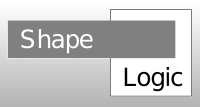
This page is about the goal driven declarative programming from ShapeLogic 0.2 to 0.8. It is not currently under development, but might be suited for handling reasoning under uncertainty, so the code is left in. The Java package for this is org.shapelogic.logic.
This was fine for handling simple rules applied to one polygon.
This is the first approach for declarative programming, used until ShapeLogic 0.8.
E.g. the context makes it possible to have the string "Letter" bound to both "A" and "B" at the same time in difference context. When matching a letter it will have a context for A and one for B, eventually one will be chosen, and the other discarded. The context is set up a hierarchically, like in most programming languages, so that names bound in a higher context can be seen in a lower one. So the string polygon is set at the root context level and can be seen by all the other context.
This relies on Java Expression Language (JEXL)
ShapeLogic is driven by a tree of task, the super class is called BaseTask.
A task can have sub tasks, but also have a context that inherits from the context of the parent task. Not all tasks have their own context.
For examples of simple rules and task hierarchy look in the classes
At the top level of the tree there is an Exclusive or task, XOrTask. Underneath is an AndTask for each letter. For each AndTask there are several simple property rules, of type ParametricRuleTask
Each AndTask has its own context that values can be set in, but all the SimpleTasks under an AndTask share a context. When a letter is finally chosen then the context from the chosen context is propagated up.
The vectorizer will put a MultiLinePolygon object into the string "polygon" in a JEXL context.
Then there are rules that go in and look at the object using reflection. Here is an example of a simple NumericRule:
NumericRule("A", "pointCount", "polygon.getPoints().size()", 5.),
Here is an example of all the rules for a letter:
NumericRule[] numericRulesForA = {
new NumericRule("A", POINT_COUNT, POINT_COUNT_EX, 5.),
new NumericRule("A", LINE_COUNT, LINE_COUNT_EX, 5.),
new NumericRule("A", HORIZONTAL_LINE_COUNT, HORIZONTAL_LINE_COUNT_EX, 1.),
new NumericRule("A", VERTICAL_LINE_COUNT, VERTICAL_LINE_COUNT_EX, 0.),
new NumericRule("A", END_POINT_COUNT, END_POINT_COUNT_EX, 2.),
where
POINT_COUNT = "pointCount"; POINT_COUNT_EX = "polygon.getPoints().size()"
All these rules are combined into an AndTask. A whole letter match will then be an XOrTask with an AndTask for each letter.
Here is a little more of about the influence for declarative goal driven logic engine.
Up till ShapeLogic v 0.9 goal driven tasks with subtasks was a corner stone in the logic for image processing. Starting in ShapeLogic v 1.0 this is getting replace by a lazy stream based approach that is simpler and more powerful.
Prolog was all the rage in the early 1980s, the Japanese 5 generation project was mainly based on Prolog. It turned out that it did not scale well to real world problems, partly because it was only good at handling symbolic information and not doing computations, and Prolog fell out of favor.
Despite this, I still think programming in Prolog is almost as simple as SQL.
ShapeLogic is trying to preserve this simplicity of Prolog, while maintaining ability to do efficient numerical calculations.
ShapeLogic is not using backtracking or unification, 2 of the main components in Prolog, but shares the idea of programming as goals and tasks with sub goals or horn clauses
Unlike Prolog, ShapeLogic can have multiple values for a name at the same time, and can explore different choices at the same time.
Oz is an experimental language boasting:
ShapeLogic merges contexts when faced with different options in a similar way to Oz, though this is not fully implemented yet.
There are currently 3 main places where logic expressions can be placed:
Found named values are set in a JEXL context and expressions can be evaluated here too.
They are sub class of the Parametric Rule Tasks. They come in 2 flavors now:
You can also do logical combinations of the filter tasks:
So if you have one class with a filter criteria that is filtering:
You can combine them with and and to get a filter that filters, T junctions in the upper half.
The rules for all the capital letters can be found in the class: LetterTaskFactory.java
So each line will be translated into one task / goal.
new NumericRule("A", POINT_COUNT, polygon, VAR_SIZE_START + POINT_COUNT_EX + VAR_SIZE_END,"==", 5.),
new NumericRule("A", HOLE_COUNT, polygon, VAR + HOLE_COUNT_EX, "==", 1.),
new NumericRule("A", T_JUNCTION_LEFT_POINT_COUNT, polygon, FILTER_START + T_JUNCTION_LEFT_POINT_COUNT_EX + FILTER_END,"==", 1.),
new NumericRule("A", T_JUNCTION_RIGHT_POINT_COUNT, polygon, filter(T_JUNCTION_RIGHT_POINT_COUNT_EX),"==", 1.),
new NumericRule("A", END_POINT_BOTTOM_POINT_COUNT, polygon, filter(END_POINT_BOTTOM_POINT_COUNT_EX), "==", 2.),
new NumericRule("A", HORIZONTAL_LINE_COUNT, polygon, size(HORIZONTAL_LINE_COUNT_EX), "==", 1.),
new NumericRule("A", VERTICAL_LINE_COUNT, polygon, size(VERTICAL_LINE_COUNT_EX), "==", 0.),
new NumericRule("A", END_POINT_COUNT, polygon, VAR + END_POINT_COUNT_EX, "==", 2.),
new NumericRule("A", SOFT_POINT_COUNT, polygon, size(SOFT_POINT_COUNT_ANN_EX), "==", 0.),
All rules work in a JEXL context.
Steps when running letter match:
new NumericRule("A", HOLE_COUNT, polygon, VAR + HOLE_COUNT_EX, "==", 1.),
This will be transformed into a task that:
It is using # as a place holder for the name of the variable from last field.
E.g. "ploygon.holeCount"
Takes the variable coming in from the third field and add that to the expression in HOLE_COUNT_EX.
Evaluate the expression that the string constant VERTICAL_LINE_COUNT_EX.
This will return a collection of lines.
Then does a size() call on that to see how many element there are in it.
When you need filter a collection with the criteria expression inside the filter.
And then see how many elements the filter returns.
So in this case you start with all the points in the polygon.
The string: END_POINT_BOTTOM_POINT_COUNT_EX has the value:
"PointOfTypeFilter(PointType.END_POINT) && PointBelowFilter(0.5)"
This is a composite criteria that checks that the point is an end point and that it is in the lower half of the bounding box for the polygon.
You can use the normal boolean operators in the filter expression: and, or, not.